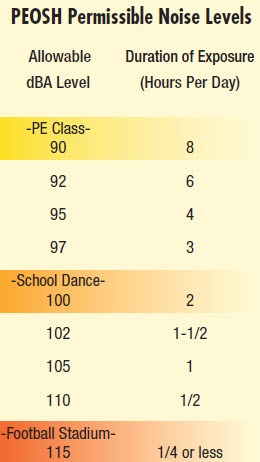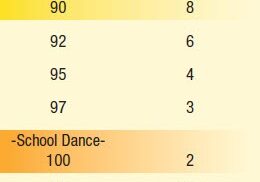Some school staff may be exposed to enough noise to cause hearing loss. Those at risk include physical education, shop, and music teachers; custodial and food service workers; and bus drivers. All school staff may be exposed to enough noise to cause stress and interfere with communication between staff and students. If loud noise sources can be quieted, overall noise in the school is also reduced. For example, soundproofing a music room may benefit the whole school as well as staff and students using the room.
Noise sources from outside schools include highways, trains, aircraft, grounds maintenance, construction activity, and playground and athletic field activity. Noise sources from inside schools include:
- Heating, ventilation, and air-conditioning (HVAC) systems
- Computers, printers, photocopiers, and other office equipment
- Building maintenance, renovation, cafeteria, and cleaning activities, tools, and machines
- Classroom activities such as drama, band, and vocal music practice, physical education class, and vocationaltechnical classes
- Socializing, especially in buses, hallways, and cafeterias
- Chair scraping, especially in elementary classrooms Noise in schools can be worsened by overcrowding, open floor plans without internal walls, having noisy areas near instructional spaces, and hard or high ceilings that create echoes.
Hearing loss Hearing damage can begin at exposures as low as 80 decibels (dBA) over an eight-hour day. Some average sound levels are shown in the sidebar. After working in a noisy environment, staff members may experience temporary hearing loss. Normal hearing returns after some time, depending upon the individual and the severity and length of the exposure.
Permanent hearing loss, on the other hand, may occur from exposure to loud noises for an extended period without protection. A hearing aid or surgery cannot help noise-induced hearing loss. Since hearing loss occurs gradually, individuals may not realize that they have permanently lost some of their hearing until it is too late.
Other health effects
Noise also affects health in other ways. It causes stress and increased blood pressure, and may contribute to heart disease and ulcers. Working in a noisy environment for long periods can make staff tired, nervous, and irritable. Noise in the classroom may decrease staff and student motivation, attention, memory, and thus academic achievement.
Teachers and educational support professionals who must use their voice a lot, especially if they must raise their voice to be heard, suffer a high rate of voice disorders such as hoarseness, discomfort with speaking, and tired, weak, and effortful speech.
Noise reduction
Noise inside schools can be reduced by:
- Replacing existing ceiling tiles with high-noise reduction coefficient (NRC)-rated acoustical tiles
- Adding sound-absorbing panels high on walls at sides and rear of room
- Diagnosing and servicing noisy HVAC systems
- Rubber tips or tennis balls on the legs of tables and chairs
- Seating students in small groups to reduce their need to speak loudly
- Turning off background music
- Adding good quality seals and gaskets to doorways if noise enters there
- Closing, sealing or installing sound-reducing windows if noise enters there
- Scheduling fewer students to use the playground, gym, or cafeteria at the same time
- Doubling the distance from a noise source reduces sound levels to one fourth
- Highway sound barriers can reduce the loudness of traffic noise by as much as one-half
Microphone amplification of a teacher’s voice facilitates communication only in one direction and does not eliminate the negative effects of noise exposure.
Local association action plan
- Work with your UniServ field rep to survey staff and create a “noise blueprint” showing noise sources inside and outside the school.
- Ask the district to reduce noise sources, starting with the ones of most concern. There are many resources available. See the websites listed under “Resources.”
- Assist staff with noise-related hearing or voice problems.
- Enlist parents of hearing-impaired and other special-needs students as allies. These students generally require spaces with low-background noise.
- Ensure the district complies with Americans with Disabilities Act (ADA) requirements for reasonable accommodation for hearing-impaired staff and students.
- Ensure the district complies with the Public Employees Occupational Safety and Health (PEOSH) noise standard.
Resources
 Healthy School Facility Environments, Noise and Acoustics webpage www.state.nj.us/health/healthy schools/acoustics.shtml Quiet Classrooms website www.quietclassrooms.org Clearinghouse on Educational Facilities, Classroom Acoustics Resource List www.edfacilities.org/rl/acoustics.cfm
Healthy School Facility Environments, Noise and Acoustics webpage www.state.nj.us/health/healthy schools/acoustics.shtml Quiet Classrooms website www.quietclassrooms.org Clearinghouse on Educational Facilities, Classroom Acoustics Resource List www.edfacilities.org/rl/acoustics.cfm
The PEOSH Noise Standard, 1910.95
The PEOSH noise standard limits employee exposures to 90 decibels (dBA) averaged over an eight-hour day. No employee may be exposed to noise in excess of 115 dBA without earplugs or muffs that will reduce the exposure below 115 dBA.
The PEOSH Permissible Noise Levels chart shows allowable exposure levels that are equivalent to a 90 dBA eighthour average. For example, someone exposed to 95 dBA of noise could only be exposed for four hours a day.
The standard requires that all areas suspected to be over 85 dBA must be monitored. If noise levels are above 90 dBA, the district must first attempt to use engineering controls to bring noise levels down below 90 dBA before relying on earplugs or muffs.
If employee exposure exceeds 85 dBA averaged over eight hours, the PEOSH standard requires the district to provide annual hearing tests and a choice of free hearing protection. Staff members are entitled to get a copy of the test results, and must be informed of any hearing loss.
